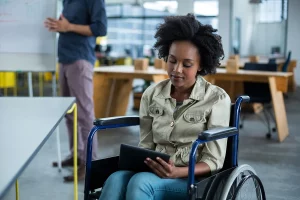In our quest for inclusive living spaces, technology emerges as a crucial ally in providing tailored assistance to individuals with disabilities. Innovative tools bridge accessibility gaps, empowering users to confidently tackle daily obstacles. What are the key challenges in creating disability-friendly environments, and how can cutting-edge tech solutions overcome these barriers? Exploring the fusion of technology and accessibility leads us to ponder: What lies ahead for disability-friendly living, and how can we leverage technology to foster a more inclusive world?
Key Takeaways
- Technology advancements, like AI-powered assistive tools and accessible virtual reality, revolutionize Disability-Friendly Living by providing equal access to opportunities.
- Smart home devices, such as voice-controlled lighting and doorbells with video and audio, enhance independence and confidence for individuals with disabilities.
- Personalized assistive technology solutions, tailored to unique needs and preferences, empower individuals to navigate daily life with confidence and independence.
- Inclusive design principles prioritize accessibility, integrating advanced technologies and accessible furniture to create adaptable living spaces that cater to individual requirements.
- Future Accessible Living spaces will prioritize accessibility, with architects and designers leveraging cutting-edge technologies to create inclusive and comfortable environments.
Challenges in Disability-Friendly Living
For individuals with disabilities, managing everyday tasks can be a daunting experience, as they often face numerous hindrances that impede their ability to live independently, emphasizing the urgent need for disability-friendly living solutions. These challenges can include inaccessible infrastructure, limited mobility, and social stigma, all of which can significantly affect their quality of life and overall well-being.
Emerging Tech for Inclusive Spaces
Advancements in technology are revolutionizing the concept of inclusive spaces, offering creative solutions to overcome the obstacles faced by individuals with disabilities in their daily lives. State-of-the-art technologies, such as accessible virtual reality and AI-powered assistive tools, are transforming Accessible Living by providing equal access to education, employment, and social opportunities.
Smart Home Devices for Accessibility
Incorporating cutting-edge home devices into daily life can significantly improve Disability Friendly Living, enabling individuals with disabilities to navigate their living spaces with increased independence and confidence. These devices can assist with:
- Advanced voice-controlled lighting and temperature for effortless ambiance adjustments.
- Smart doorbells with video and audio for safe and convenient visitor communication.
- Accessible kitchen appliances with automated meal preparation and cooking.
These forward-thinking solutions empower individuals to live more comfortably and autonomously in their Accessible Living spaces.
Personalized Assistive Technology Solutions
Personalized assistive technology solutions play a vital role in Accessible Living, offering tailored support to individuals with unique needs and preferences. These solutions provide adaptive tools, such as communication aids, mobility devices, and cognitive support systems, empowering individuals to navigate daily life with confidence and independence.
Future of Disability-Friendly Living Spaces
As architects and designers increasingly prioritize accessibility, the future of Disability Friendly Living Spaces is being shaped by advanced technologies and inclusive design principles that put the needs of individuals with disabilities at the forefront. This shift will result in:
- Smart homes that adapt to individual needs.
- Accessible furniture designed for comfort and ease.
- Virtual assistance integrated into daily living.
These innovations will revolutionize the concept of Accessible Living, empowering individuals to live independently and comfortably.
Frequently Asked Questions
Can Disability-Friendly Living Spaces Be Adapted for People With Temporary Disabilities?
Yes, disability-friendly living spaces can be adapted for people with temporary disabilities, incorporating flexible design elements and assistive technologies to guarantee inclusive and accessible environments for individuals with diverse needs.
How Do I Choose the Right Assistive Technology for My Specific Needs?
To select the appropriate assistive technology, evaluate your particular needs, explore options, and seek advice from a healthcare professional; take into account factors such as price, user-friendliness, and compatibility with current devices and systems.
Are Smart Home Devices for Accessibility Compatible With Existing Home Systems?
Most smart home devices for accessibility are designed to integrate seamlessly with existing home systems, guaranteeing compatibility and ease of use; nonetheless, it’s crucial to research and consult with professionals to guarantee a smooth integration process.
Can I Customize My Disability-Friendly Living Space to Fit My Personal Style?
Absolutely, personalize your disability-friendly living space to reflect your unique style and preferences. Integrate assistive technologies, modify furniture, and choose color schemes that promote comfort, independence, and self-expression, ensuring a harmonious blend of functionality and personal taste.’
What Are the Costs Associated With Installing Disability-Friendly Home Modifications?
The expenses of installing disability-friendly home modifications vary widely, depending on the type and scope of the project, with average costs ranging from $3,000 to $20,000 or more, depending on the specific needs and requirements.
Conclusion
To sum up, disability-friendly living is transformed by personalized support through technology. Emerging innovations and smart home devices improve accessibility, promoting inclusivity and independence. Personalized assistive technology solutions cater to individual needs, nurturing confidence and self-sufficiency. As technology continues to advance, the future of Accessible living spaces holds promise for unprecedented accessibility and empowerment.
Also read: Position-specific Baseball Gear Advances in Software


